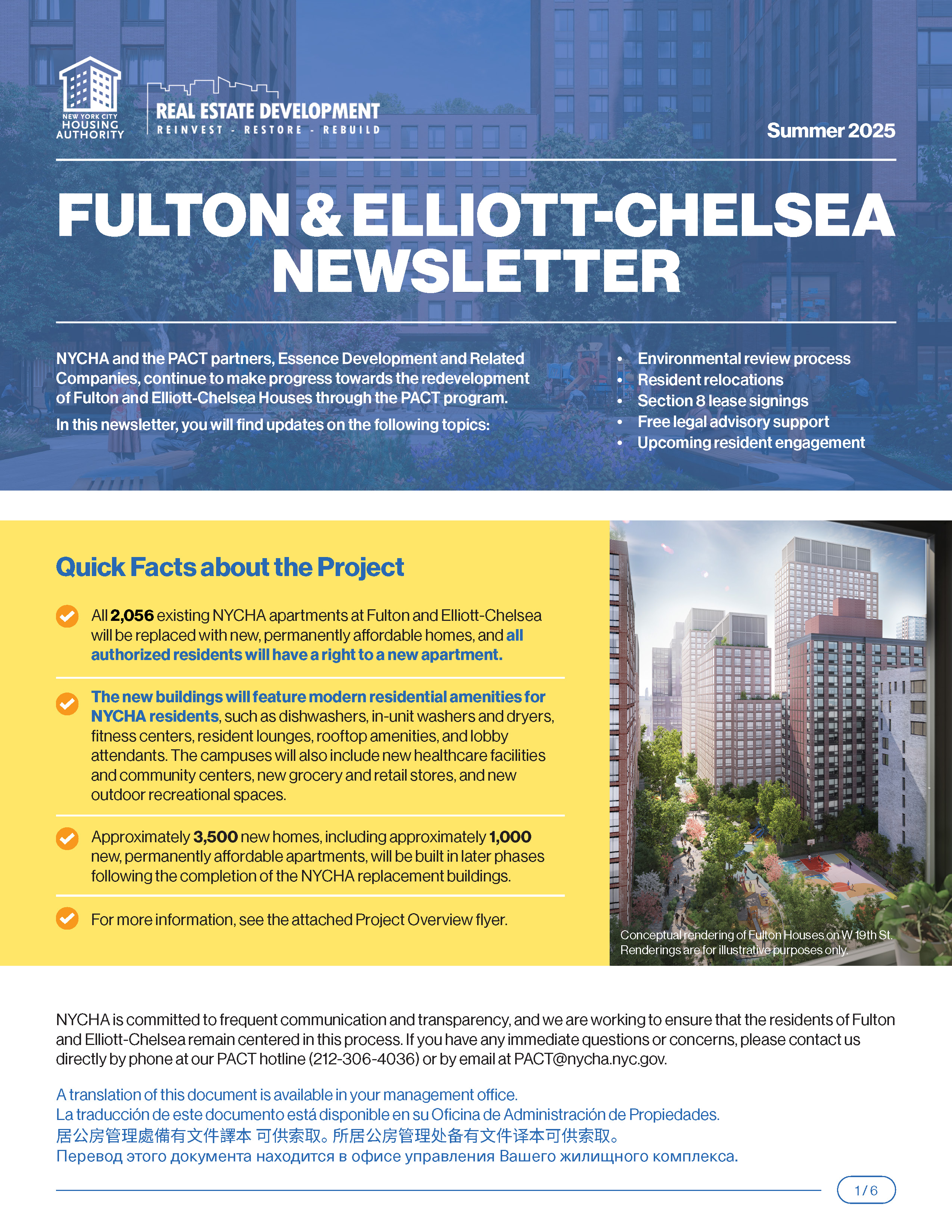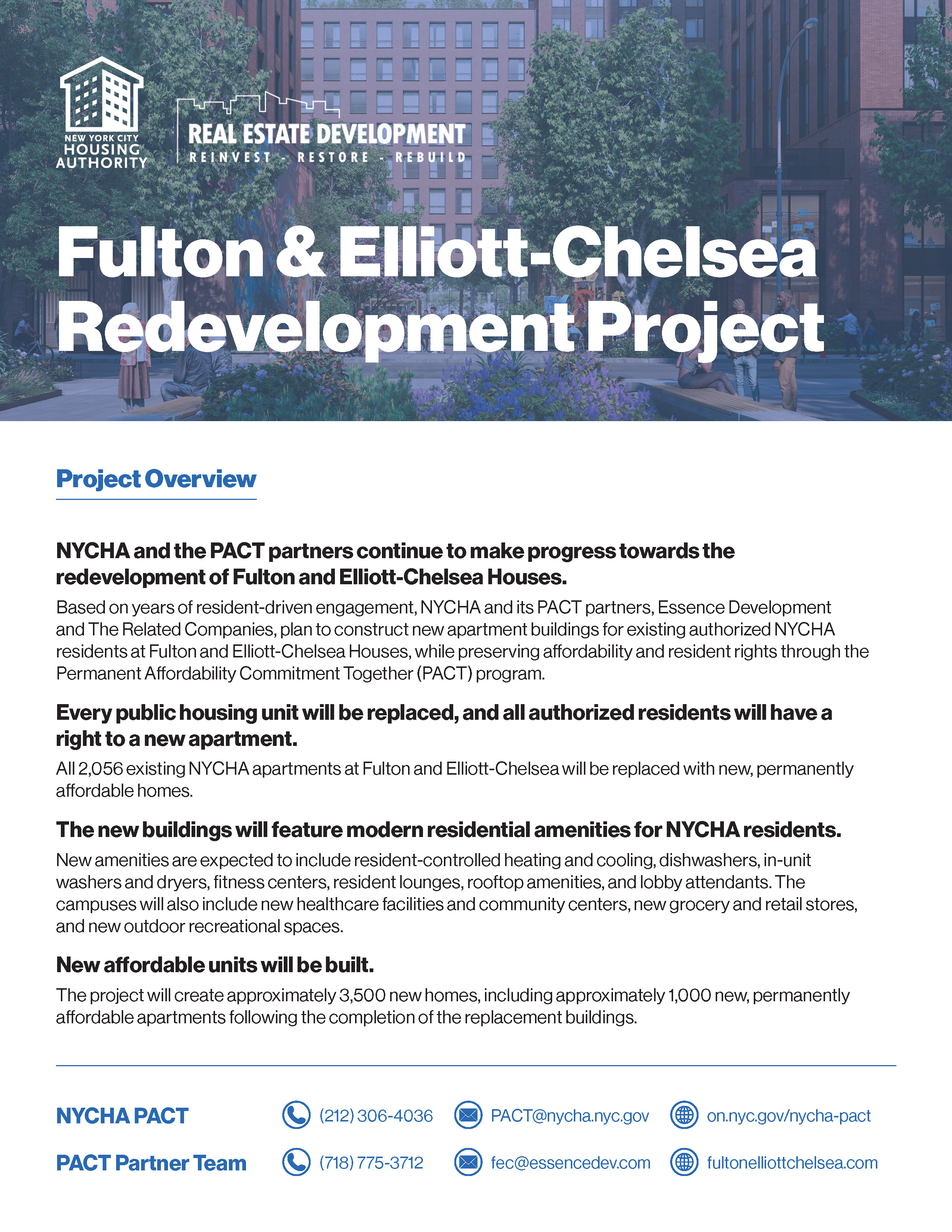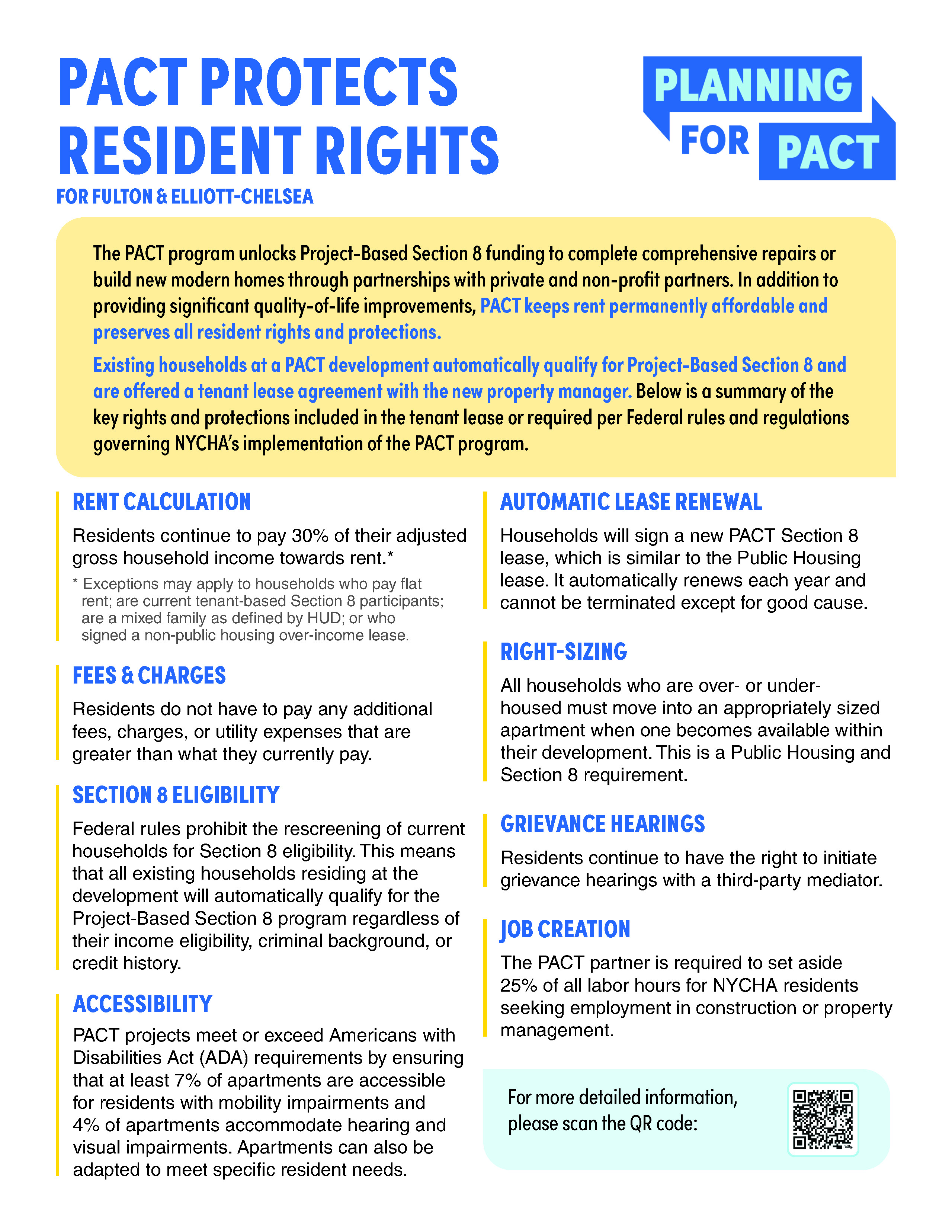
 NYC Housing Authority311
NYC Housing Authority311 Search all NYC.gov websites
Search all NYC.gov websites
Fulton & Elliott-Chelsea Redevelopment Project

This page serves as a central hub for all official NYCHA updates about the Fulton and Elliott-Chelsea Redevelopment Project. For additional details and the latest updates from the PACT partners, please visit fultonelliottchelsea.com.
Project Overview
NYCHA and the PACT partners continue to make progress towards the redevelopment of Fulton and Elliott-Chelsea Houses.
Based on years of resident-driven engagement, NYCHA and its PACT partners, Essence Development and The Related Companies, plan to construct new apartment buildings for existing authorized NYCHA residents at Fulton and Elliott-Chelsea Houses, while preserving affordability and resident rights through the Permanent Affordability Commitment Together (PACT) program.
Every public housing unit will be replaced, and all authorized residents will have a right to a new apartment. All 2,056 existing NYCHA apartments at Fulton and Elliott-Chelsea will be replaced with new, permanently affordable homes.
The new buildings will feature modern residential amenities for NYCHA residents. New amenities are expected to include resident-controlled heating and cooling, dishwashers, in-unit washers and dryers, fitness centers, resident lounges, rooftop gardens, and lobby attendants. The campuses will also include new healthcare facilities and community centers, new grocery and retail stores, and new outdoor recreational spaces.
New affordable units will be built. The project will create approximately 3,500 new homes, including approximately 1,000 new, permanently affordable apartments.
Key Documents
How We Got Here
More than 4,500 New Yorkers call Fulton Houses and Elliott-Chelsea Houses home. Since the buildings were completed roughly 60 years ago, generations of residents have lived and grown up at the two large developments in Manhattan’s Chelsea neighborhood.
But over the years, due to insufficient funding from the federal government, the buildings have deteriorated. Currently, residents of the developments live with leaks, mold, asbestos, security issues, and more.
To address these problems, NYCHA entered the development into the PACT program. The program unlocks additional federal funding for maintenance and repairs by converting developments from Section 9 housing to Project-Based Section 8 housing, a more robust and stable source of funding. In the PACT program, NYCHA continues to own the land and buildings, but brings on private partners to conduct repairs and manage the communities.
Years of Resident Engagement
NYCHA began engaging with Fulton and Elliott Chelsea residents about their communities’ needs in 2019. In October of that year, the Chelsea NYCHA Working Group was formed to evaluate options and propose solutions to address the properties’ significant capital needs. The Working Group released a report in February 2021, recommending strategies such as mixed-income housing, retail upgrades, and a potential PACT conversion.
Alongside the Working Group’s efforts, NYCHA has regularly engaged residents through meetings, events, surveys, inspections, and multilingual outreach to share updates and gather input.
In 2021, a resident committee selected Essence Development and The Related Companies as PACT partners to support the redevelopment of their homes. In 2022, the PACT partner team conducted building conditions assessments that revealed significantly more challenging and costly conditions than originally anticipated.
In mid-2023, following a period of extensive community engagement to understand residents’ preferred path forward through a survey, NYCHA, resident leaders, and the PACT partner team announced a new plan that would result in the complete rebuilding of both campuses.
Since then, NYCHA and the PACT team have continued to work with residents on the design of the new campuses. Those conversations and resident priorities are reflected in this Community Plan for the new project.
2023 Resident Survey
In February 2023, resident association leadership from Fulton and Elliott-Chelsea Houses met with city, state, and federal elected officials, local stakeholders, NYCHA leadership, and principals from Essence Development and Related Companies (“PACT Partner”) to express their desire to commence a robust resident engagement process at the two campuses to explore resident interest in rebuilding all 2,056 apartments. The resident association leadership requested that NYCHA and the PACT Partner work with them to design the engagement process and a strategy for gauging resident preferences for rebuilding or rehabilitation.
Over a 60-day period beginning in March 2023, with the support of resident association leaders, NYCHA and the PACT Partner hosted 35 scheduled town hall sessions in multiple languages; canvassed thousands of residents across both campuses; provided weekly Saturday tours of new affordable construction developments at Hunter’s Point South and Roosevelt Island; and distributed information packets to every apartment. In addition to the 35 scheduled town hall meetings, smaller groups of residents requested meetings with NYCHA and the PACT Partners to ask additional questions.
NYCHA and the PACT Partner surveyed residents of Fulton and Elliott-Chelsea Houses to understand whether they preferred to move forward with the rehabilitation of the existing buildings, as originally planned, or proceed with a new proposal that would replace all existing buildings through new construction. Residents 18 years of age and older on leases could indicate their preference using either an online or paper survey.
The survey, town halls, and tours were all designed to function as an integrated program. Residents were encouraged to attend a town hall session – during which all aspects of demolition, rebuilding, relocation, and rehabilitation were discussed – before completing the survey. The survey was intended to serve as an engagement tool that would inform the direction of the project and future community engagement processes.
To support the integrity of the process, the Citizens Housing & Planning Council (CHPC) served as an independent third party that reviewed and tabulated the survey results. CHPC received all online and paper surveys, verified resident eligibility, performed QA functions, and summarized the results, which are presented in the tables below.
Based on CHPC’s analysis, 969 residents participated in the survey, which represents approximately 29% of the total eligible population across both campuses. Approximately 37% of all households had at least one individual who submitted a survey response. Of those residents who submitted a response, 57% indicated a preference for new construction/full replacement of existing units.
Survey Process and Results Presentation
|
Overall Survey Participation |
Surveys Received |
|
Total surveys submitted |
1,183 |
|
Total surveys submitted from verified residents* |
1,157 |
|
Total surveys submitted from verified residents with duplicates resolved** |
969 |
|
* Verified residents must be at least 18 years old and an authorized household member |
|
|
** Duplicate and conflicting responses were removed from this count. When one individual submitted multiple matching responses, one was counted. When one individual submitted multiple conflicting responses, none were counted. |
|
|
Development |
Number of Leased Residents (over 18) |
Total Surveys Submitted |
Survey Participation (as % of Eligible Residents) |
Total Households |
Households with ≥ 1 Survey Submitted |
Survey Participation (as % of of Total Households) |
|
Fulton |
1,621 |
476 |
29% |
911 |
329 |
36% |
|
Elliott-Chelsea |
1,767 |
493 |
28% |
1,053 |
396 |
38% |
|
Total |
3,388 |
969 |
29% |
1,964 |
725 |
37% |
|
Survey Option Selected |
Surveys Submitted |
% of Total |
|
Fulton Houses |
476 |
100% |
|
Rehabilitation of existing units |
182 |
38% |
|
New construction/full replacement of existing units |
294 |
62% |
|
Elliott-Chelsea Houses |
493 |
100% |
|
Rehabilitation of existing units |
237 |
48% |
|
New construction/full replacement of existing units |
256 |
52% |
|
Total Combined |
969 |
100% |
|
Rehabilitation of existing units |
419 |
43% |
|
New construction/full replacement of existing units |
550 |
57% |
Environmental Review
The environmental review for the Fulton and Elliott-Chelsea campuses is now complete.
To facilitate the redevelopment of Fulton and Elliott-Chelsea, the impacts to the human, built, and natural environment in the area were analyzed through a National Environmental Policy Act (NEPA) Environmental Impact Statement (EIS). The EIS was undertaken by the New York City Department of Housing Preservation and Development (HPD), as lead federal agency and Responsible Entity on behalf of the U.S. Department of Housing and Urban Development (HUD). NYCHA served as project sponsor and joint-lead agency for the environmental review alongside HPD.
The project has identified approvals and involvement from federal, state, and city agencies. In coordination with NYCHA, HPD prepared an EIS to fulfill the environmental review requirements of NEPA, and technical analysis areas outlined in the New York State Environmental Quality Review Act (SEQRA) and City Environmental Quality Review (CEQR).
Learn more about NEPA:
Notice of Intent to Prepare an Environmental Impact Statement (NOI-EIS)
The EIS process formally began with the publication of a Notice of Intent to Prepare an Environmental Impact Statement (NOI-EIS) in the Federal Register on January 8, 2024. The NOI-EIS signaled that HPD and NYCHA would prepare an EIS for the Fulton and Elliott-Chelsea Redevelopment Project, in compliance with NEPA.
Scoping
Scoping is a public process to determine the issues that that will be analyzed in the EIS. HPD and NYCHA, as joint lead agencies, gathered input from federal, state, local, and tribal governments and agencies, as well as the public, to identify areas of concern, potential impacts, and possible alternatives to the project. HPD and NYCHA then determined the scope and the significant issues to be analyzed in the EIS and eliminated non-significant issues from further study.
A Draft Scope of Work (DSOW) was issued alongside the NOI-EIS, outlining the potential environmental issues and areas of study. The DSOW also identified reasonable alternatives to the project for evaluation.
Three public scoping meetings were held in early February 2024 to gather input from the residents, government agencies, tribes, and other members of the public. Residents and stakeholders submitted comments verbally at meetings or in writing during the public comment period, which remained open from January 8, 2025 to March 8, 2025.
- FEC Scoping Meeting (Fulton), February 1, 2024: View Recording
- FEC Scoping Meeting (Zoom), February 5, 2024: View Recording
- FEC Scoping Meeting (Elliott-Chelsea), February 7, 2024: View Recording
Public comments received during the comment period were considered in the preparation of a Final Scope of Work (FSOW). The FSOW and Formal Response to Comments were released on March 28, 2025.
Draft Environmental Impact Statement (DEIS)
The Draft Environmental Impact Statement (DEIS) was published alongside the FSOW on March 28, 2025. The DEIS presented a comprehensive, technical analysis of the project’s potential impacts and alternatives, as required under NEPA.
- Draft Environmental Impact Statement (DEIS): English| Español | 繁體 | 简体 | Русский
- Notice of Availability: English| Español | 繁體 |简体 | Русский
- Early Floodplain Notice: English| Español | 繁體 / 简体 | Русский
A 52-day public comment period followed, from March 28, 2025 to May 19, 2025, during which residents, agencies, and stakeholders could submit public comments by mail, email, or verbally at one of three public hearings.
- DEIS Public Hearing (Fulton Senior Center), April 23, 2025
- DEIS Public Hearing (Elliott-Chelsea Community Center), April 24, 2025
- DEIS Public Hearing (Virtually on Zoom), May 8, 2025: View Recording
- DEIS Public Hearing Presentation Deck: English| Español | 繁體 / 简体 | Русский
This comment period lasted 52 days due to a nationwide Zoom outage occurring on the originally scheduled Zoom public hearing day (April 16, 2025). Because of this, the Zoom public hearing was rescheduled, and the public comment period was extended from May 12, 2025 to May 19, 2025. Notice was provided on both HPD and NYCHA’s webpages, as well as through email notification to those registered for the original Zoom public hearing date.
Final Environmental Impact Statement (FEIS)
On June 27, 2025, HPD and NYCHA released a Final Environmental Impact Statement (FEIS). The FEIS includes the contents of the DEIS, along with a summary of the comments received verbally at the public hearing or in writing during the DEIS public comment period, as well as responses to those comments. Changes to the document text and graphics were made between DEIS and FEIS, as necessary, in response to these comments.
The FEIS includes any measures to minimize identified significant adverse environmental impacts to the greatest extent practicable.
Since HPD and NYCHA verified that the FEIS was complete, a Notice of Availability was published in the Federal Register on June 27, 2025.
- Final Environmental Impact Statement (FEIS)
- Notice of Availability
- Final Floodplain Notice
- Notice of Intent to Request Release of Funds
Record of Decision (ROD)
The environmental review formally concluded with the issuance of the Joint Record of Decision (ROD) and Findings Statement on July 28, 2025, by HPD and NYCHA.
The ROD follows the publication of the Final Environmental Impact Statement (FEIS) and sets forth that HPD and NYCHA have given due consideration to the Draft Scope of Work for the Preparation of an EIS (DSOW), Final Scope of Work for the Preparation of an EIS (FSOW), and the Draft and Final Environmental Impact Statements (DEIS and FEIS) prepared for the project and also public comments submitted. The lead agencies have considered all reasonable alternatives, information, analyses, and comments submitted by federal, state, local, and tribal governments and agencies, as well as the public throughout the process of the EIS.
Joint ROD and Findings Statement documents the findings and decision to proceed with the Proposed Project as described in the FEIS. Additionally released alongside the Joint Record of Statement and Findings Statement was the Final Memorandum of Agreement concluding the SHPO Section 106 Process as well as the Restrictive Declaration which includes all identified mitigation and Project Components Related to the Environment (PCREs).
Preparing for Redevelopment
Phase 0: Pre-construction
Residents of Chelsea Addition (436 West 27th Drive) and Fulton Building 11 (401 West 19th Street and 419 West 19th Street) – a total of 105 households, representing only 6% of all households in Fulton and Elliott-Chelsea – have began moving into refurbished vacant apartments in other buildings on the FEC campus in the summer of 2025.
At the conclusion of the environmental review process, on July 28, 2025, these residents were issued a 90-Day Notice informing them that they had at least 90 days until the required moving process would begin. However, residents could choose to move into refurbished apartments sooner.
All Phase 0 residents have been offered new leases for their relocation apartment, as well as a Right to Return Agreement that guarantees them a right-sized apartment in the new building, once constructed.Phase 1: NYCHA Replacement Buildings 1
Based on the current estimations of the proposed project schedule, construction on the first replacement buildings will take three to four years to be built.
Residents whose buildings will move into the first phase of replacement buildings will sign new Project-Based Section 8 PACT leases prior to the replacement buildings being completed. NYCHA and the PACT partner will conduct additional outreach to all households moving into the first phase of replacement buildings to further explain the process.
The Rental Assistance Demonstration (RAD) program and other federal regulations ensure that homes remain permanently affordable and resident rights are fully preserved. Moving assistance will be paid for by the PACT Partner.
Residents from the following addresses, including residents from the former Fulton 11 and Chelsea Addition, will move into the Phase 1 replacement buildings once the buildings are complete:
- Fulton 5: 427 West 17th Street and 431 West 17th Street
- Fulton 7: 121 9th Avenue and 117 9th Avenue
- Fulton 8: 401 West 18th Street and 411 West 18th Street
- Fulton 10: 412 W 19th Street and 400 West 19th Street
- Elliott 1: 288 10th Avenue and 450 West 27th Drive
- Chelsea 2: 420 West 26th Street and 415 West 25th Street
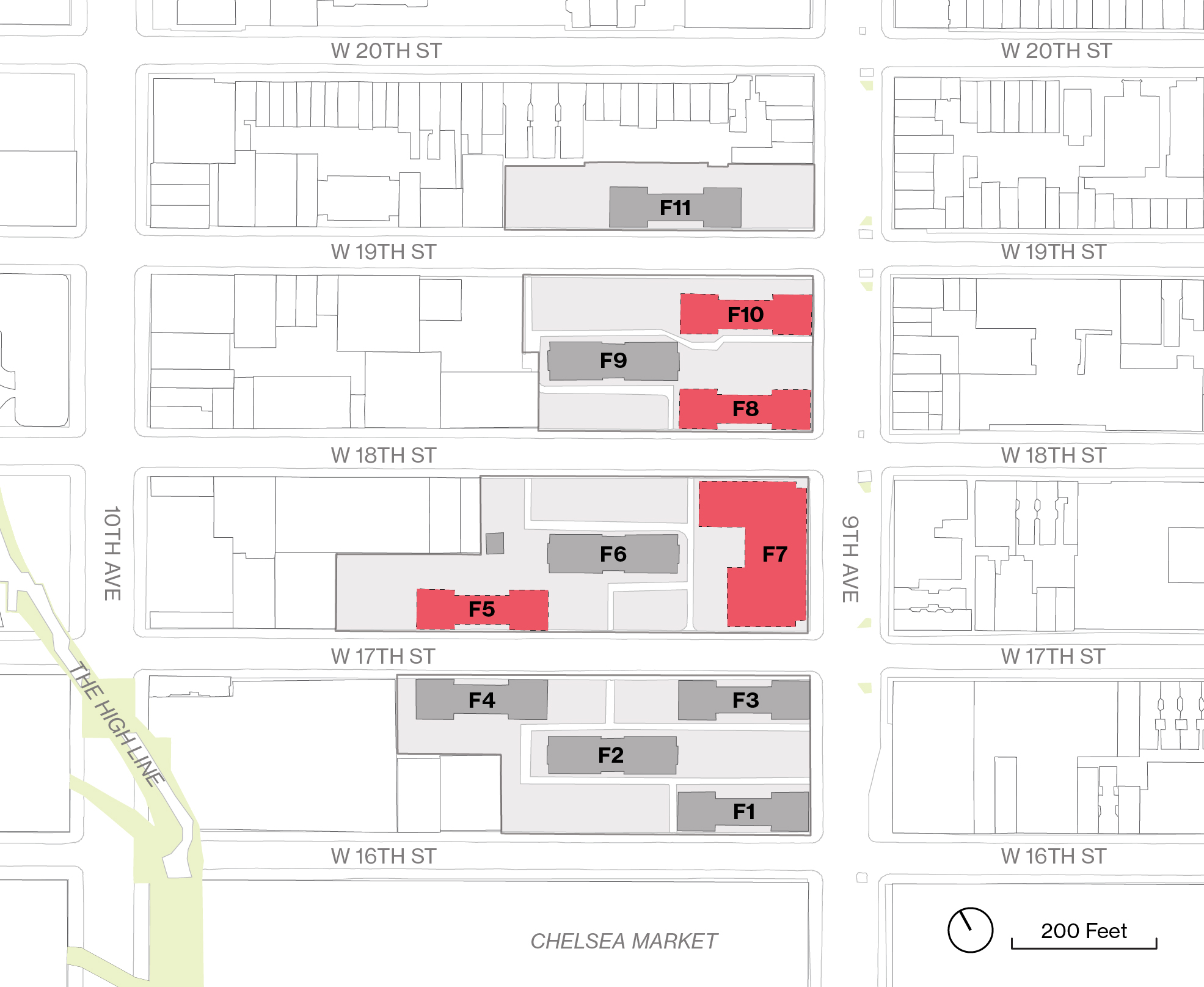 Fulton
Fulton
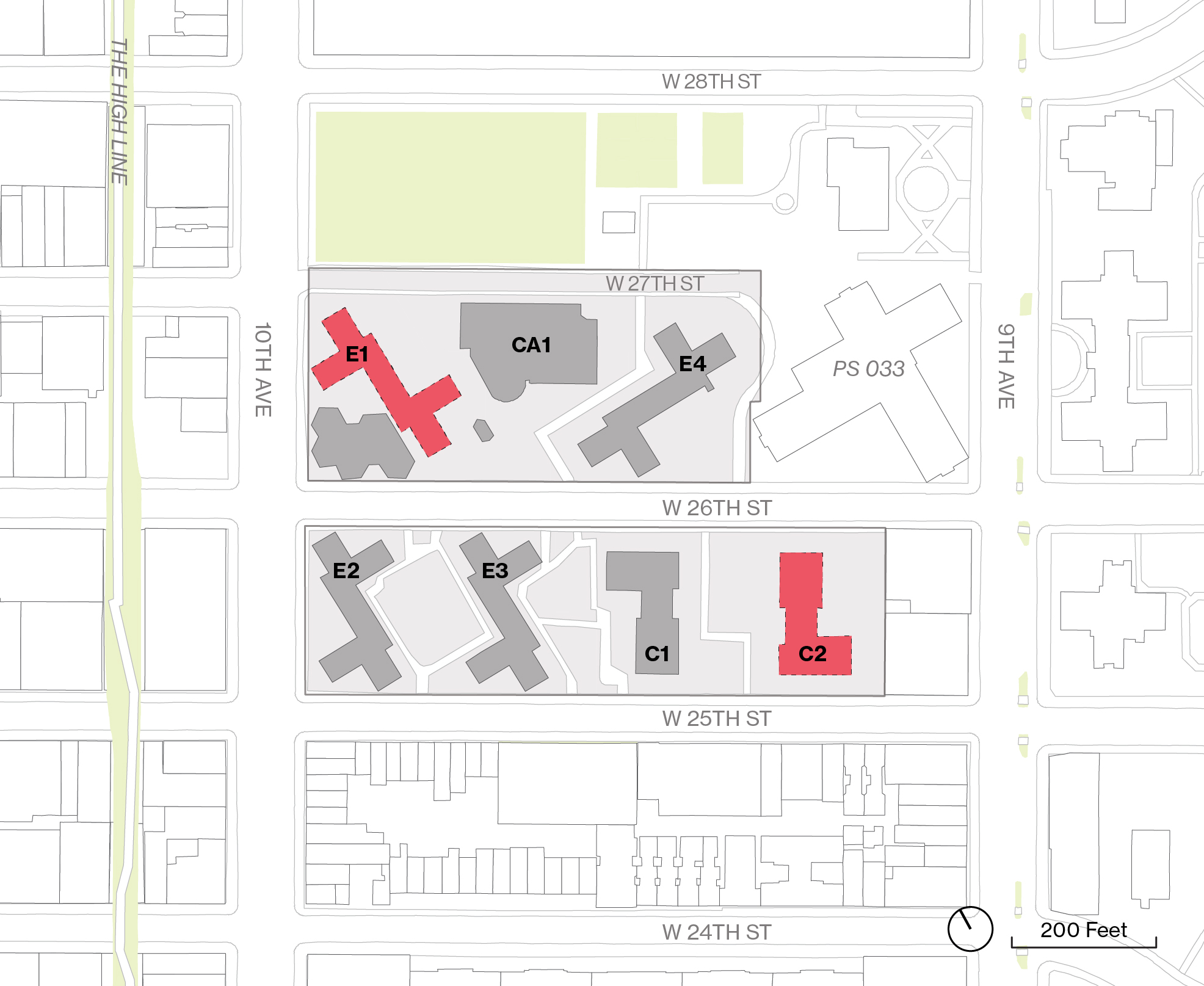 Elliott-Chelsea
Elliott-Chelsea
More information about resident relocations:
- Relocation Plan: English| Español | 繁體 / 简体 | Русский
- Resident Move Guide: English| Español | 繁體 / 简体 | Русский
More information about the phasing of the project:
Resident Resources
Project Overview
Fulton and Elliott-Chelsea Redevelopment Project Overview
English | Español | 繁體 / 简体 | Русский
Resident Rights and Protections
HUD Presentation for Resident Rights and Protections under RAD
In July 2025, the U.S. Department of Housing and Urban Development (HUD) representatives delivered a presentation to Fulton and Elliott-Chelsea residents about resident rights and protections through the Rental Assistance Demonstration (RAD) and PACT programs.
PACT Protects Resident Rights
English | Español | 繁體 / 简体 | Русский
Summary of Policies Preserving Resident Rights Under PACT
English | Español | 繁體 /简体 | Русский
Free Legal Advisory Support
View the flyer:English | Español | 繁體 /简体 | Русский
With resources provided by NYCHA, Convergent Law will provide free, independent legal assistance to Fulton and Elliott-Chelsea Houses residents who have questions about the PACT process, the PACT Section 8 lease, or any other legal questions relating to the PACT program.
To speak with a member of the Convergent Law team, please call (973) 358-2500.
Please note that Convergent Law is available to address legal questions relating to the PACT conversion only. Convergent Law cannot provide legal representation or serve as personal or business legal counsel to any residents.
Resident Relocations
Relocation Plan
English | Español | 繁體 / 简体 | Русский
Resident Move Guide
English | Español | 繁體 / 简体 | Русский
Fulton & Elliott-Chelsea Newsletters
Winter 2024
NYCHA and HPD began the environmental review with the scoping process.
English | Español | 繁體 / 简体 | Русский
Spring 2024
NYCHA provided a breakdown of the most important facts about the PACT program, including that residents preserve all rights and protections they currently enjoy as public housing tenants.
English | Español | 繁體 / 简体 | Русский
Spring 2025
NYCHA shared updates on the General Information Notice, which outlines future temporary relocation plans for Chelsea Addition and Fulton Building 11 residents as part of the redevelopment process. This newsletter also provides information on the Environmental Review process, Bridge Plan, and ongoing resident engagement.
English | Español | 繁體 / 简体 | Русский
Summer 2025
NYCHA and PACT partners continue to move forward with the redevelopment of the Fulton and Elliott-Chelsea campuses. This newsletter provides key updates on resident relocations, PACT lease signings, environmental review milestones, free legal support, and upcoming resident meeting schedules.
English | Español | 繁體 / 简体 | Русский
Chelsea NYCHA Working Group
Working Group Summary Booklet
English | Español | 繁體 / 简体 | Русский
Working Group Final Report
English | Español | 繁體 / 简体 | Русский
Press Release
Final Scope of Work & Draft Environmental Impact Statement for the Proposed Redevelopment of Fulton & Elliott-Chelsea Houses, March 28, 2025
Next Phase of Repair Work at Fulton and Elliott-Chelsea Houses to Begin, October 31, 2024
NYCHA Starts Environmental Review Process for the Redevelopment of Fulton and Elliott-Chelsea, January 8, 2024
Residents and NYCHA Announce Plans for Complete Rebuilding of Fulton and Elliott-Chelsea Houses, June 21, 2023
PACT Partner Selection, December 1, 2021
Resident Notices
General Information Notice (GIN)
The General Information Notice (GIN) is a required U.S. Department of Housing and Urban Development (HUD) notice informing residents from Fulton 11 and Chelsea Addition that they will have to relocate to facility the redevelopment process.
English | Español | 繁體 / 简体 | РусскийNotice of Intent to Acquire (NOIA)
The Notice of Intent to Acquire (NOIA) is a required notice from the U.S. Department of Housing and Urban Development (HUD), which informs residents about the proposed plans for the redevelopment of Fulton and Elliott-Chelsea.
All LanguagesFulton Elliott-Chelsea Right to Return Agreement
All authorized residents of Fulton 11 and Chelsea Addition have been offered a refurbished unit on the Fulton or Elliott-Chelsea campus while the new buildings are under construction, and also a Right to Return Agreement, which guarantees them an apartment in the NYCHA replacement buildings.
English | Español | 繁體 / 简体 | Русский90-Day Notice
The 90-Day Notice explains that the residents from Fulton 11 and Chelsea-Addition will be temporarily relocated to a newly refurbished apartment within the Fulton and Elliott-Chelsea campus.
English | Español | 繁體 / 简体 | Русский


